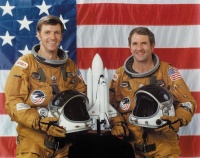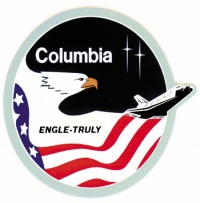STS-2
From The Space Library
 | |
| Organization | NASA-Office of Space Flight (United States), NASA-Office of Space Science Applications (United States) |
|---|---|
| Mission type | Earth Science,Human Crew,Life Science |
| Launch date | November 12, 1981 |
| Launch vehicle | Space Shuttle |
| Launch site | Cape Canaveral, United States |
| COSPAR ID | 1981-111A |
| Inclination | 38 degrees |
| Experiments | Here |
| Alternate Names | OSTA 1/STS 2,Shuttle OFT 2,12953 |
| Additional Information | Here |
| Data Collection | Here |
| Payload Mass Up | 2542 kg |
| Payload Mass Down | kg |
| Orbiter | Columbia |
| Lift Off Mass | 2,031,958.18 kg |
| Orbiter Weight at Liftoff | 104,867.27 kg |
| Orbiter Weight at Landing | 92,846.36 kg |
| Landed | Runway 23 dry lake bed at Edwards Air Force Base, Calif. |
| Orbits of Earth | 36 |
| Orbital Altitude | 137 nautical miles (157 statute miles) |
Contents |
[edit] Crew
- Commander: Joe Engle
- Pilot: Richard Truly
[edit] Mission
The second flight of the Space Shuttle (STS-2) carried the first scientific payload OSTA-1 (Office of Space and Terrestrial Application 1). The instruments from the OSTA-1 payload were designed to perform remote sensing of the earth's atmosphere, oceans, and land resources. During its time in orbit, the Shuttle assumed an earth-viewing orientation, thus accommodating the experiments of the OSTA-1 payload. In this attitude, called Z-axis local vertical (ZLV), the Shuttle's payload bay faces the earth on a line perpendicular to the earth's surface. The OSTA-1 payload consisted of (1) a shuttle imaging radar-A (SIR-A), (2) a shuttle multispectral infrared radiometer (SMIRR), (3) a feature identification and location experiment (FILE), (4) a measurement of air pollution from satellites (MAPS), (5) an ocean color experiment (OCE), (6) a night/day optical survey of lightning (NOSL), and (7) a helfex bioengineering test (HBT). The first five instruments were located in the payload bay. A pallet, supplied by the European Space Agency, made the interface between the payload bay and these five experiments. The NOSL and HBT instruments were located in the crew compartment. Due to the loss of one of three fuel cells, the STS-2 mission was shortened from the planned 124-h to a 54-h minimum mission. The OSTA-1 payload was activated approximately 4.5 h after launch. The earth-viewing time was reduced from the planned 88 h to 36 h. The STS-2 mission successfully demonstrated the capability of the Space Shuttle to conduct scientific research. For more detailed descriptions of the OSTA-1 payload, see "OSTA-1 Experiments," JSC 17059, NASA-JSC, and Science, v. 218, n. 4576, pp. 993-1033, 1982.
[edit] Payload
Office of Space and Terrestrial Applications (OSTA)-1 experiments; Orbiter Experiments (OEX)
[edit] Books about the Space Shuttle Program
Buy This Book Click here |
Buy This Book here |
Buy This Book Click here |
Buy This Book Click here |





